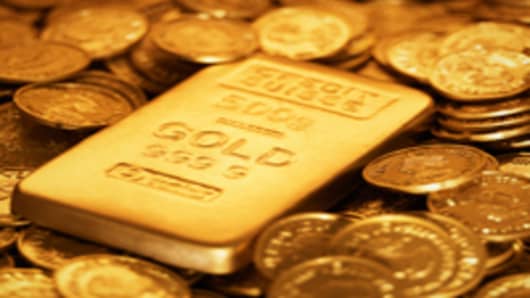The price of gold could be the biggest winner from the Federal Reserve’s announcement of a third round of quantitative easing (QE3) on Thursday, according to analysts and gold investors.
In the hours following the announcement by Chairman Ben Bernanke that the Fed would buy $40 billion of mortgage-backed securities per month until economic conditions improve, the price of gold hit a six-month high of $1,774.96 per ounce. (Read More:Fed Pulls Trigger on QE3)
“I will never sell my gold as long as we have people like Bernanke at the Fed and fiscal deficits as far as we can see,” Marc Faber, a long-term gold bull and author of the Gloom, Boom and Doom Report, told CNBC Friday.
“With more and more QE globally, the price will trend higher. I don’t know how far it will go – we need to call Benny and the ECB. There will be plenty more."
He said that he is hoping for a correction to around $1750 per ounce, then for gold to hold around there before rising again. (Read More: Marc Faber on Gold)
While the price of gold was boosted substantially by the first round of quantitative easing in 2008-10, the second round, which took place in calmer markets, had very little impact.
The Credit Suisse commodities team forecast a peak gold price of $1,820 in the first quarter of 2013 and argued that there is “a much lower conviction bull case for gold” because of faltering conviction in gold capital gains.
The main arguments for gold being boosted this time round include lack of confidence in governments, central bank buying and weakness in the U.S. dollarcaused by quantitative easing. (Read More: Fallout From the Fed)
“You’ve got gold, a fixed quantity, and central banks printing more money. Ergo, gold becomes more expensive,” Richard Cookson, global chief investment officer at Citi Private Bank, told CNBC Friday.
“The cost of holding gold is zip, because interest rates are effectively zero. So you print more currency, and the gold price goes up because you price in that extra currency.”
Lack of belief that governments will be able to fix their economic woes is the main factor driving the cost of gold, according to Martin Arnold, senior analyst at ETF Securities.
“The real question is: do you have faith in policymakers to deliver a solution? What we’re seeing is that the answer is no from the investment community,” he said.
Arnold believes that the Fed have created a “sweet spot” for the price of gold to rise, and predicted that it will get past $1,790 and then looking at record highs of around $1,900.
He added that high prices are having an impact on the jewelry sector, particularly in the Indian physical market.
“There is physical buying, but it’s coming from central banks who are trying to diversify their asset base when the race to debase currencies is continuing,” he said.
“If you’ve got two comparatively low-yielding assets and one is being debased, one becomes a lot more appealing in that situation.”
The U.S. dollar, in which gold is priced, has weakened since the QE3 announcement.
Written by Catherine Boyle, CNBC. Twitter: @catboyle01



